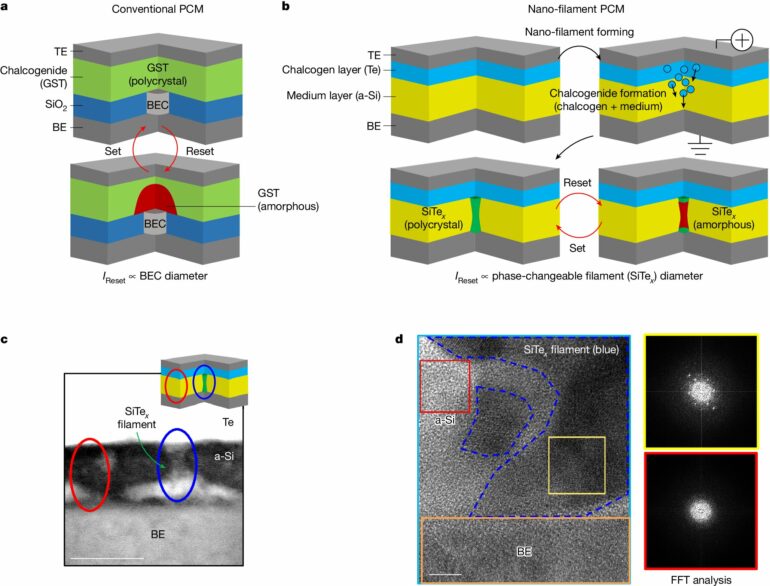A team of Korean researchers has developed a new memory device that can be used to replace existing memory or be used in implementing neuromorphic computing for next-generation artificial intelligence hardware for its low processing costs and its ultra-low–power consumption.
Professor Shinhyun Choi’s research team in the KAIST School of Electrical Engineering developed the next-generation phase change memory device featuring ultra-low–power consumption that can replace DRAM and NAND flash memory. The research is published in the journal Nature.
Existing phase change memory has problems such as an expensive fabrication process for making highly scaled devices and requiring a substantial amount of power for operation. To solve these problems, Professor Choi’s research team developed an ultra-low–power phase change memory device by electrically forming a very small nanometer (nm) scale phase changeable filament without expensive fabrication processes. This new development has the advantage of not only having a very low processing cost but also of enabling operating with ultra-low power consumption.
DRAM, one of the most popularly used memory, is very fast, but has volatile characteristics in which data disappears when the power is turned off. NAND flash memory, a storage device, has relatively slow read/write speeds, but it has non-volatile characteristic that enables it to preserve the data even when the power is cut off.
Phase change memory, on the other hand, combines the advantages of both DRAM and NAND flash memory, offering high speed and non-volatile characteristics. For this reason, phase change memory is being highlighted as the next-generation memory that can replace existing memory, and is being actively researched as a memory technology or neuromorphic computing technology that mimics the human brain.
However, conventional phase change memory devices require a substantial amount of power to operate, making it difficult to make practical large-capacity memory products or realize a neuromorphic computing system. In order to maximize the thermal efficiency for memory device operation, previous research efforts focused on reducing the power consumption by shrinking the physical size of the device through the use of state-of-the-art lithography technologies, but they were met with limitations in terms of practicality as the degree of improvement in power consumption was minimal whereas the cost and the difficulty of fabrication increased with each improvement.
In order to solve the power consumption problem of phase change memory, Professor Shinhyun Choi’s research team created a method to electrically form phase change materials in extremely small area, successfully implementing an ultra-low–power phase change memory device that consumes 15 times less power than a conventional phase change memory device fabricated with the expensive lithography tool.
Professor Shinhyun Choi expressed strong confidence in how this research will span out in the future in the new field of research saying, “The phase change memory device we have developed is significant as it offers a novel approach to solve the lingering problems in producing a memory device at a greatly improved manufacturing cost and energy efficiency.
“We expect the results of our study to become the foundation of future electronic engineering, enabling various applications including high-density three-dimensional vertical memory and neuromorphic computing systems as it opened up the possibilities to choose from a variety of materials.”
More information:
See-On Park et al, Phase-change memory via a phase-changeable self-confined nano-filament, Nature (2024). DOI: 10.1038/s41586-024-07230-5
Provided by
The Korea Advanced Institute of Science and Technology (KAIST)
Citation:
Researchers develop a novel ultra-low–power memory for neuromorphic computing (2024, April 4)



